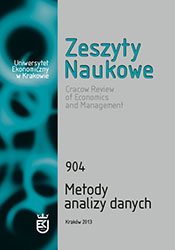Analiza struktury łańcuchów środków-celów w skróconych wywiadach drabinkowych
DOI:
https://doi.org/10.15678/krem.819Słowa kluczowe:
podejście środków-celów, wywiad drabinkowy, asymetryczna analiza korespondencji, optymalizacja struktury drabinekAbstrakt
W artykule przedstawiono nowy sposób oceny jakości drabinek tworzonych przez respondentów w czasie wywiadu ladderingowego, uwzględniający różnice zarówno w kolejności czasowej, jak i w częstości ich tworzenia przez respondentów. Wprowadzono wskaźnik tzw. centralności drabinek oparty na znanym w analizie dziedziny kulturowej wskaźniku Smitha. Ponadto zaproponowano nową metodę analizy danych ladderingowych za pomocą asymetrycznej analizy korespondencji sumarycznej macierzy drabinek. Jej zastosowanie pozwala otrzymać dodatkową informację na temat dominujących wymiarów w strukturze łańcuchów środków-celów, a także wyznaczyć drabinki prominentne o największym wkładzie w bezwładność układu.Pobrania
Bibliografia
Ajzen I., Fishbein M. [1980], Understanding Attitudes and Predicting Social Behavior, Prentice Hall, Englewood Cliffs.
Axelrod J.N. [1968], Attitude Measures That Predict Purchase, „Journal of Advertising Research", vol. 8(1).
Bech-Larsen T., Nielsen N.A. [1999], A Comparison of Five Elicitation Techniques for Elicitation of Attributes of Low Involvement Products, „Journal of Economic Psychology", vol. 20, nr 3. DOI: https://doi.org/10.1016/S0167-4870(99)00011-2
D'Ambra L., Lauro N.C. [1992], Non Symmetrical Exploratory Data Analysis, „Statistica Applicata", vol. 4, nr 4.
Grunert K.G., Grunert S.C. [1995], Measuring Subjective Meaning Structures by the Laddering Method: Theoretical Considerations and Methodological Problems, „International Journal of Research in Marketing", vol. 12, nr 3. DOI: https://doi.org/10.1016/0167-8116(95)00022-T
Gutman J. [1982], A Means-End Chain Model Based on Consumer Categorization Process, „Journal of Marketing", vol. 46(2). DOI: https://doi.org/10.2307/3203341
Gutman J. [1997], Means-End Chains as Goal Hierarchies, „Psychology and Marketing", vol. 14, nr 6. DOI: https://doi.org/10.1002/(SICI)1520-6793(199709)14:6<545::AID-MAR2>3.0.CO;2-7
Huber F., Beckmann S.C., Herrmann A. [2004], Means-End Analysis: Does the Affective State Influence Information Processing Style?, „Psychology and Marketing", vol. 21(9). DOI: https://doi.org/10.1002/mar.20026
Kąciak E., Cullen C.W. [2006], Analysis of Means-End Chain Data in Marketing Research, „Journal of Targeting, Measurement and Analysis for Marketing", vol. 15(1). DOI: https://doi.org/10.1057/palgrave.jt.5750028
Kąciak E., Cullen C.W. [2009], A Method of Abbreviating a Laddering Survey, „Journal of Targeting, Measurement and Analysis for Marketing", vol. 17(2). DOI: https://doi.org/10.1057/jt.2009.4
Kąciak E., Cullen C.W., Sagan A. [2010], The Quality of Ladders Generated by Abbreviated Hard Laddering, „Journal of Targeting, Measurement and Analysis for Marketing", vol. 18, nr 3-4. DOI: https://doi.org/10.1057/jt.2010.20
Kroonenberg P., Lombardo R. [1999], Nonsymmetric Correspondence Analysis: A Tool for Analysing Contingency Tables with a Dependence Structure, „Multivariate Behavioral Research", vol. 34, nr 3. DOI: https://doi.org/10.1207/S15327906MBR3403_4
Olson J.C., Reynolds T.J. [2001], The Means-End Approach to Understanding Consumer Decision Making [w:] Understanding Consumer Decision Making: The Means-End Approach to Marketing and Advertising Strategy, ed. T.J. Reynolds, J.C. Olson, Lawrence Earlbaum Associates, Mahwah.
Phillips J.M., Reynolds T.J. [2009], A Hard Look at Hard Laddering. A Comparison of Studies Examining the Hierarchical Structure of Means-End Theory, „Qualitative Market Research: An International Journal", vol. 12(1). DOI: https://doi.org/10.1108/13522750910927232
Pitts R.E., Wong J.K., Whalen J.D. [1991], Consumers' Evaluative Structures in Two Ethical Situations: A Means-End Approach, „Journal of Business Research", vol. 22, nr 2. DOI: https://doi.org/10.1016/0148-2963(91)90046-Z
Reynolds T.J. [2006], Methodological and Strategy Development Implications of Decision Segmentation, „Journal of Advertising Research", December.
Reynolds T.J., Gutman J. [1988], Laddering Theory, Method, Analysis, and Interpretation, „Journal of Advertising Research", February/March.
Reynolds T.J., Gutman J. [2001], Laddering Theory, Method, Analysis, and Interpretation [w:] Understanding Consumer Decision Making: The Means-End Approach to Marketing and Advertising Strategy, ed. T.J. Reynolds, J.C. Olson, Lawrence Earlbaum Associates, Mahwah.
Reynolds T.J., Phillips J.M. [2008], A Review and Comparative Analysis of Laddering Research Methods: Recommendations for Quality Metrics, „Review of Marketing Research", vol. 5(6).
Sagan A. [2004], Structural Model of Product Meaning Using Means-End Approach [w:] Innovations in Classification Data Science, and Information Systems, ed. D. Baier, K.-D. Wernecke, Brandenburg University of Technology, Springer-Verlag, Cottbus.
ter Hofstede F., Steenkamp J.-B.E.M., Wedel M. [1999], International Market Segmentation Based on Consumer-Product Relations, „Journal of Marketing Research", vol. 36, February. DOI: https://doi.org/10.2307/3151911
Woodside A.G. [2004], Advancing Means-End Chains by Incorporating Heider's Balance Theory and Fournier's Consumer-Brand Relationship Typology, „Psychology and Marketing", vol. 21(4). DOI: https://doi.org/10.1002/mar.20006
Woodside A.G., Trappey R.J. III [1992], Finding Why Customers Shop Your Store and Buy Your Brand: Automatic Cognitive Processing Model of Primary Choice, „Journal of Advertising Research", November/December.

